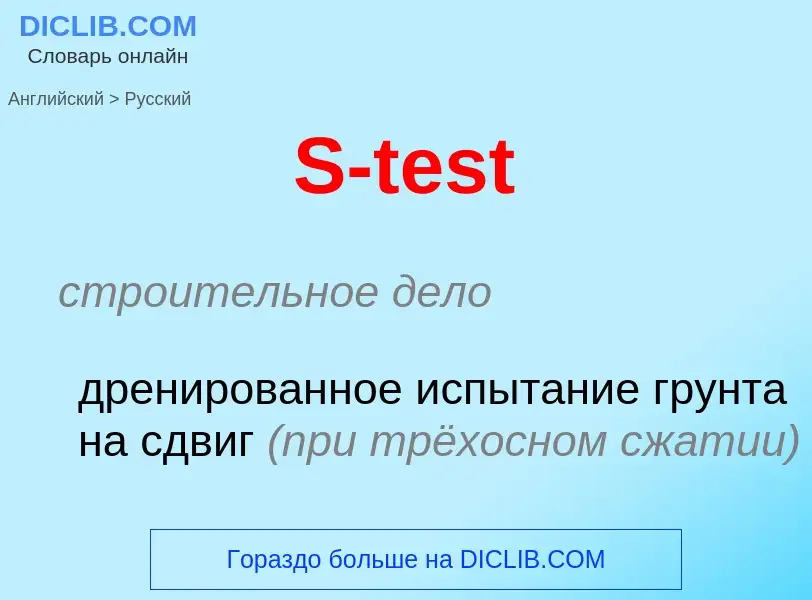Перевод и анализ слов искусственным интеллектом ChatGPT
На этой странице Вы можете получить подробный анализ слова или словосочетания, произведенный с помощью лучшей на сегодняшний день технологии искусственного интеллекта:
- как употребляется слово
- частота употребления
- используется оно чаще в устной или письменной речи
- варианты перевода слова
- примеры употребления (несколько фраз с переводом)
- этимология
S-test - перевод на русский
строительное дело
дренированное испытание грунта на сдвиг (при трёхосном сжатии)
медицина
реакция Манту
медицина
непрямая проба Кумбса
общая лексика
Employee Self-Service
самообслуживание сотрудников
внутренняя электронная система предприятия, как правило, базирующаяся на веб-технологиях, для самообслуживания сотрудников при отъезде в командировку (выписка командировочных, выбор маршрута, заказ билетов и др.), составления отчета после командировки, повышения квалификации и др.
существительное
общая лексика
электронная система коммутации
синоним
[es]
существительное
общая лексика
19-я буква английского алфавита
в грам. знач. прил. (также как компонент сложных слов) имеющий форму буквы S
S-образный
Определение
Википедия

In statistics, the Kolmogorov–Smirnov test (K–S test or KS test) is a nonparametric test of the equality of continuous (or discontinuous, see Section 2.2), one-dimensional probability distributions that can be used to compare a sample with a reference probability distribution (one-sample K–S test), or to compare two samples (two-sample K–S test). In essence, the test answers the question "How likely is it that we would see a collection of samples like this if they were drawn from that probability distribution?" or, in the second case, "How likely is it that we would see two sets of samples like this if they were drawn from the same (but unknown) probability distribution?". It is named after Andrey Kolmogorov and Nikolai Smirnov.
The Kolmogorov–Smirnov statistic quantifies a distance between the empirical distribution function of the sample and the cumulative distribution function of the reference distribution, or between the empirical distribution functions of two samples. The null distribution of this statistic is calculated under the null hypothesis that the sample is drawn from the reference distribution (in the one-sample case) or that the samples are drawn from the same distribution (in the two-sample case). In the one-sample case, the distribution considered under the null hypothesis may be continuous (see Section 2), purely discrete or mixed (see Section 2.2). In the two-sample case (see Section 3), the distribution considered under the null hypothesis is a continuous distribution but is otherwise unrestricted. However, the two sample test can also be performed under more general conditions that allow for discontinuity, heterogeneity and dependence across samples.
The two-sample K–S test is one of the most useful and general nonparametric methods for comparing two samples, as it is sensitive to differences in both location and shape of the empirical cumulative distribution functions of the two samples.
The Kolmogorov–Smirnov test can be modified to serve as a goodness of fit test. In the special case of testing for normality of the distribution, samples are standardized and compared with a standard normal distribution. This is equivalent to setting the mean and variance of the reference distribution equal to the sample estimates, and it is known that using these to define the specific reference distribution changes the null distribution of the test statistic (see Test with estimated parameters). Various studies have found that, even in this corrected form, the test is less powerful for testing normality than the Shapiro–Wilk test or Anderson–Darling test. However, these other tests have their own disadvantages. For instance the Shapiro–Wilk test is known not to work well in samples with many identical values.



![PDF]]. PDF]].](https://commons.wikimedia.org/wiki/Special:FilePath/KolmogorovDistrPDF.png?width=200)

![The size of [[induration]] is measured 48–72 hours later. Erythema (redness) should not be measured. The size of [[induration]] is measured 48–72 hours later. Erythema (redness) should not be measured.](https://commons.wikimedia.org/wiki/Special:FilePath/Mantoux test.jpg?width=200)

![Late medieval German script (Swabian [[bastarda]], dated 1496) illustrating the use of long and round ''s'': ''prieſters tochter'' ("priest's daughter"). Late medieval German script (Swabian [[bastarda]], dated 1496) illustrating the use of long and round ''s'': ''prieſters tochter'' ("priest's daughter").](https://commons.wikimedia.org/wiki/Special:FilePath/Schwäbische Bastarda 1496 Schriftprobe Priesters Tochter.png?width=200)
![A letter S in the coat of arms of [[Sortavala]] A letter S in the coat of arms of [[Sortavala]]](https://commons.wikimedia.org/wiki/Special:FilePath/Sortavala COA (2020).gif?width=200)
.png?width=200)

